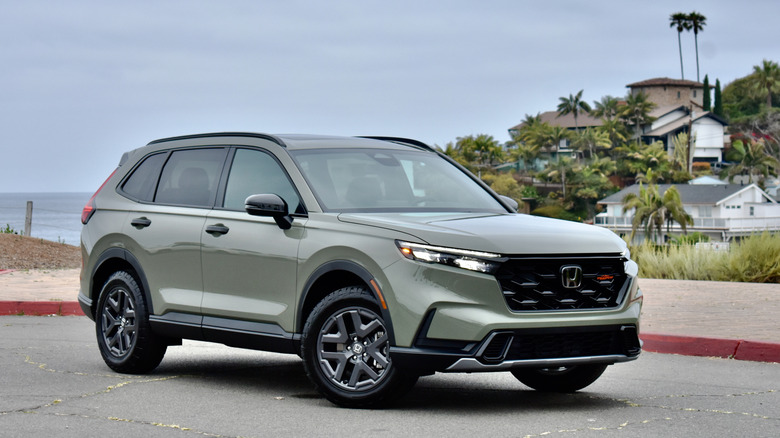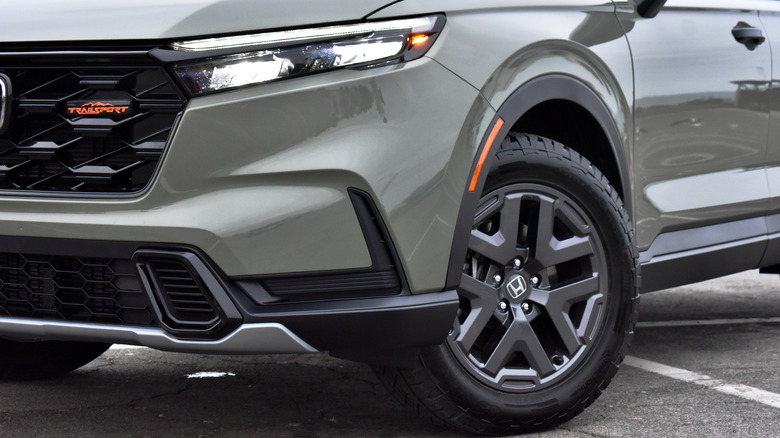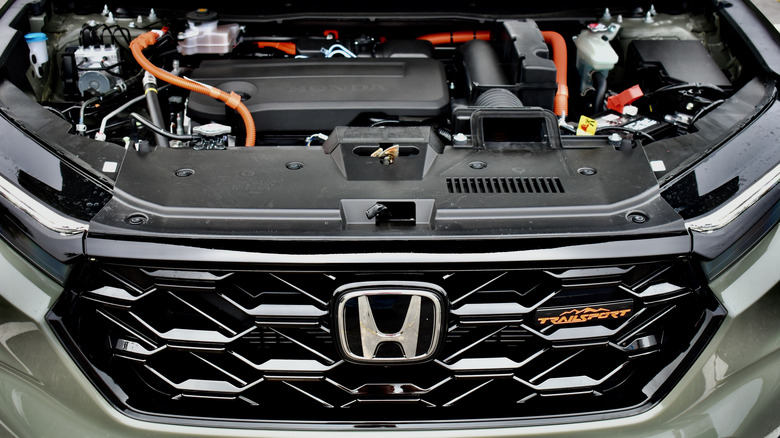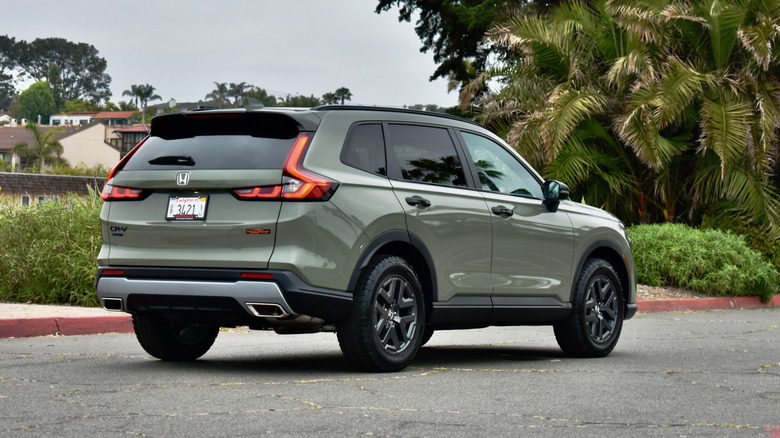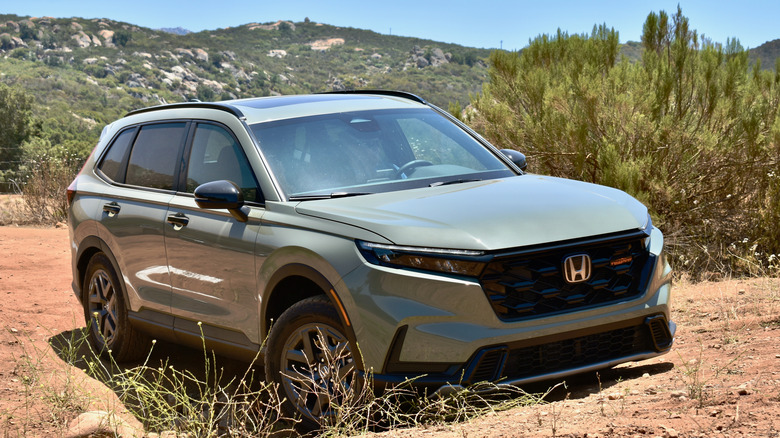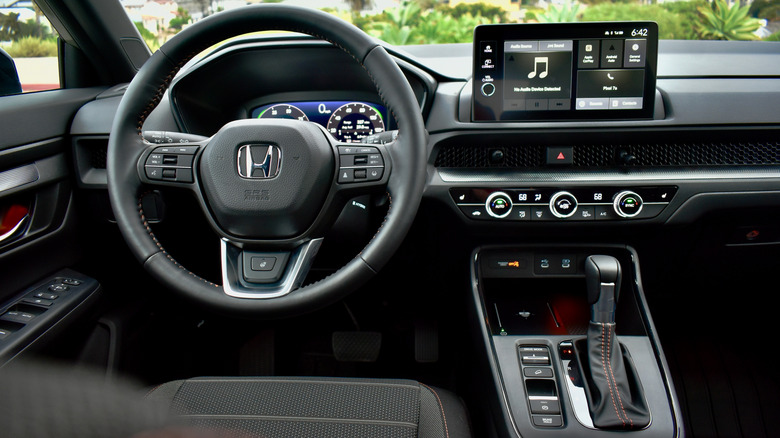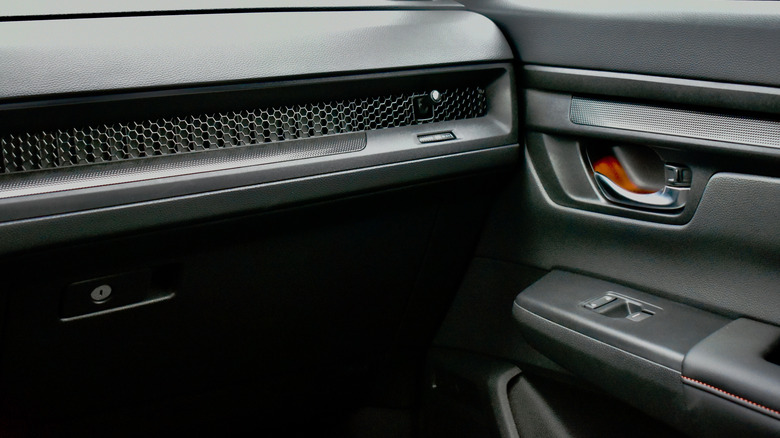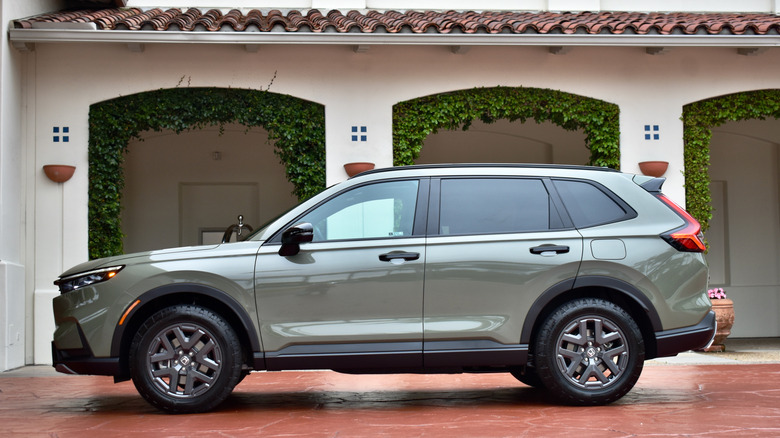2026 Honda CR-V TrailSport Hybrid First Drive: More Rugged Model Is A Niche Too Far
The Honda CR-V and its compact crossover brethren have become bestsellers by offering the utility of traditional SUVs without the compromises needed for off-road capability most people will never use. But like pet owners who splurge for expensive dog food for an imagined connection to their canines' wolf ancestry, new car shoppers are looking for a deeper connection to their crossovers' rugged roots. Or at least, that's what Honda thinks.
The 2026 Honda CR-V TrailSport brings the dirt-ready TrailSport badge previously applied to the Passport, Pilot, and Ridgeline to Honda's bestselling model. The CR-V is also the first hybrid TrailSport model, continuing Honda's strategy of bundling hybrid powertrains with higher trim levels, helping to nudge customers in the direction of these more-efficient powertrains.
But while the CR-V itself was a pioneer of the compact crossover genre, the TrailSport is more of a cover. Several equivalent diet off-road models like the Hyundai Tucson XRT, Kia Sportage X-Pro, Nissan Rogue Rock Creek, and Toyota RAV4 Hybrid Woodland already exist. And while there's no Wilderness version of the Subaru Forester Hybrid, it already has plenty of capability baked in. So where can Honda improve?
Doesn't look trail-ready
Honda didn't take any styling risks with the current-generation CR-V, and that cautious approach extends to the TrailSport model. The only differences are new front and rear fascia with silver "garnishes" meant to look like skid plates, gray 18-inch wheels mounting 235/60R18 Continental CrossContact ATR all-terrain tires, and the obligatory badging.
Dramatic styling changes aren't required here—it's hard to tell an X-Pro apart from other Sportage models, for example—but the TrailSport treatment still falls flat. More so than its rivals, the staid-looking CR-V was in need of some added visual dynamism, and this simply doesn't do that.
Nor does the TrailSport offer any advantages in ground clearance or approach and departure angles over other all-wheel drive CR-V hybrid models. However, its 8.2 inches of ground clearance is still respectable (albeit half an inch less than a Subaru Forester Hybrid's), and should be more than enough for the type of driving the TrailSport is likely to see. This is a crossover designed for dirt paths, not frame-twisting obstacle courses, after all.
Honda's hybrid system continues to impress
Those minor cosmetic changes are doing heavy lifting, as the powertrain carries over from other CR-V hybrid models. One electric motor provides propulsion, while another acts as a generator, with both being fed electricity from a 2.0-liter four-cylinder engine running on the more-efficient Atkinson cycle. That's the gasoline engine's primary function, as it only directly drives the wheels during light-throttle highway cruising. Clutches allow either the engine or traction motor to connect to the wheels, but there's no transmission as such.
This unusual hybrid system makes it easier to drive the CR-V efficiently because there's simply no advantage to thrashing it. The 204 horsepower on tap is adequate—more than the Subaru Forester Hybrid's 194 hp but less than the 231 hp of a hybrid Hyundai Tucson and 236 hp of all-wheel drive hybrid versions of the freshly redesigned Toyota RAV4—but a heavy right foot will only return more noise, not more acceleration.
That means achieving the TrailSport's EPA-estimated 35 mpg combined (38 mpg city, 33 mpg highway) in the real world should be easier, as smoother, more-efficient inputs make it more pleasant to drive. Those numbers are slightly lower than other all-wheel drive CR-V hybrids (likely owing to the all-terrain tires) but the TrailSport still matches the Forester Hybrid in combined mpg.
Drama-free on pavement
Another upside to the TrailSport's minimal mechanical changes is that they preserve the CR-V's excellent on-road driving dynamics. All-terrain tires may improve grip off-road, but they can be noisy on-road, while compromising handling. That wasn't the case here; from behind the wheel it was hard to tell that the TrailSport wasn't wearing normal all-season tires.
That lets the CR-V's chassis tuning shine. If all cars have personalities, the CR-V is an eager student trying to impress the teacher. From disciplined body control to carpool-friendly damping, the TrailSport addressed every item of the curriculum. Precise and responsive steering made navigating twisty roads easy, without the nervousness that would compromise comfort. But while the TrailSport was somewhat entertaining, it wasn't exactly fun. There's no passion behind its pursuit of an A+ on the report card.
Compact crossover buyers probably aren't looking for passion, or indeed anything specific about the way their vehicles drive. Which means Honda engineers' good work on the CR-V's regenerative braking will likely go unnoticed. The blending of regenerative and friction brakes was hard to fault, contributing to the overall sereneness of the driving experience. Paddle shifters call up an extra burst of regen, helping to simulate downshifts from the transmission this hybrid doesn't have.
All-wheel drive now works even better on dirt
Every CR-V model should drive more or less the same way on the road, though. What's supposed to set the TrailSport apart is off-road capability. But as with the exterior design, there just isn't enough here to justify the TrailSport badge.
For 2026, all-wheel drive CR-V models receive new traction-management software logic to better control wheel slippage. Essentially, the software that redistributes power between the wheels (a 50/50 front/rear torque split is the default) is more active at speeds below nine mph. That helps in situations where only one wheel is on the ground or on a non-slippery surface, but that's just generally the way all-wheel drive systems are supposed to work. It's also not unique to the TrailSport, nor is the CR-V's only other off-road-relevant driver aid, hill-descent control.
Honda only provided the opportunity to drive the TrailSport on a short dirt course that any vehicle with all-wheel drive and a reasonable amount of ground clearance should have been able to negotiate. But that demonstrates the issue with diet off-roaders like this. The base vehicle likely has more capability than the average owner will use, so small changes don't really make much of an impression. The CR-V was already enough of an SUV without the TrailSport trim.
Interior keeps it simple
Whether it's a TrailSport or one of the other trim levels, the CR-V's interior remains pleasingly basic. Honda's designers are among the few left in the auto industry who seem to actually spend a lot of time in cars.
Among new cars, the choices today generally bifurcate between cheap-looking, style-free cabins and ones with superfluous design elements or oversized screens. But even in basic-black plastic, the CR-V cabin looks great thanks to details like mesh trim on the dashboard (shared with the delightful Civic) and wing-like trim pieces in the doors, plus a tried-and-true emphasis on horizontal lines.
It's supremely functional too. From the prominent climate-control knobs to the drive-mode toggle switch, everything is easy to use. A conventional shift lever might seem a bit old fashioned these days, but at least it doesn't require any second guessing. And the TrailSport's rubber floor mats, combined with the cloth upholstery from the lower Sport trim level, are perfect for a vehicle designed for outdoor activities. Orange stitching helps liven up the cabin as well, although the TrailSport-specific "ambient lighting" is essentially a trio of dim bulbs.
The CR-V hybrid's 36.3 cubic feet of cargo space with the rear seats up remains competitive, but folding those seats yields 76.5 cubic feet that's the best among similar-sized hybrid crossovers. Headroom and legroom are competitive as well, and the thin door panels and center console create a greater feeling of spaciousness up front.
Tech that doesn't overwhelm
Just as the TrailSport is an obligatory addition to the lineup, for the 2026 model year Honda is following an industry reflex by adding bigger screens across the CR-V lineup. A 10.2-inch digital instrument cluster is now available on the TrailSport, Sport-L, and Sport Touring trim levels, and the previously-optional 9.0-inch touchscreen is now standard across the board. That also means wireless Apple CarPlay and Android Auto are now standard as well.
The interface has the same basic-but-functional vibe as the rest of the interior. The relatively small screen, propped on top of the dashboard, will have tech enthusiasts turning up their noses. But the average new car buyers this lowest-common-denominator vehicle is aiming at won't find any points of friction while using it. And while the digital instrument cluster's graphics aren't very creative, everything is presented in a clear and concise manner.
Wireless Apple CarPlay and Android Auto weren't enabled on our pre-production test car, but connecting a phone proved seamless nonetheless. Top Sport Touring models also get Google Built-in apps, but the generic interface on the TrailSport worked just fine.
2026 Honda CR-V TrailSport Hybrid Verdict
The Honda CR-V remains a great compact crossover. It's pleasant to drive, fuel-efficient in hybrid form, and has a spacious and functional interior. But, aside from the fact that competitors have already brought out similar models, it's hard to see the point of the TrailSport. It doesn't improve on other all-wheel drive CR-V models in capability, and its styling features are too subtle to make an impact on the dealership lot.
Those minimal differences are at least reflected in the pricing. At $40,195 (including a mandatory $1,395 destination charge), the TrailSport slots between the $38,525 all-wheel drive Sport Hybrid (the least-expensive hybrid model) and the $41,620 all-wheel drive Sport-L Hybrid. Note that all-wheel drive is standard on the TrailSport, but optional on the Sport and Sport-L.
A TrailSport also costs about the same as the non-hybrid Kia Sportage X-Pro, which starts at $40,985 with destination. However, it's possible to get similar capability and fuel economy from a base Subaru Forester Hybrid at $36,415. As an active-lifestyle statement, the CR-V doesn't really doing anything these crossovers don't; Honda is following the herd, rather than leading, as it did with the original CR-V nearly 30 years ago. But those decades of experience are apparent in the current CR-V's sensible design and engineering. That's where this crossover staple continues to stand out.
